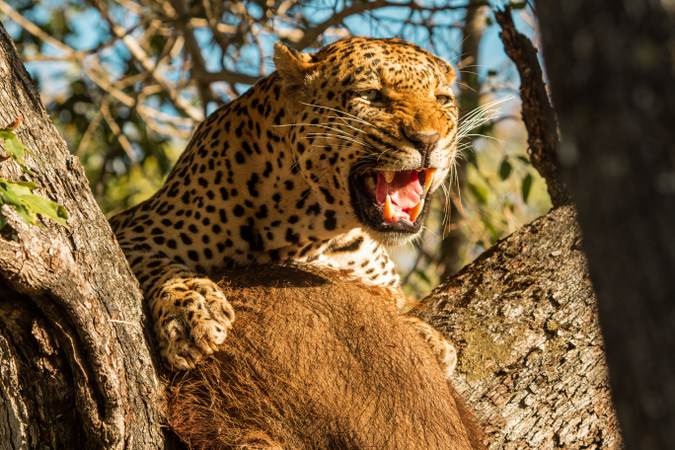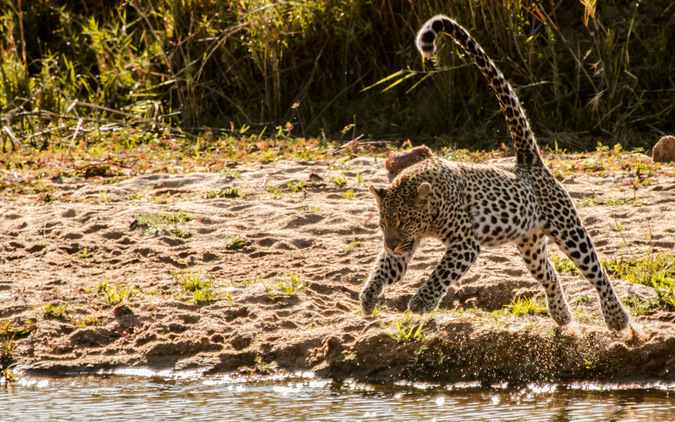| 11 Leopard facts you need to know | 您所在的位置:网站首页 › ieopard › 11 Leopard facts you need to know |
11 Leopard facts you need to know
 © Benjamin Ackerman © Benjamin Ackerman
The African leopard (Panthera pardus) is an elegant and powerfully-built predator. It is the most secretive and elusive big cat, and arguably one of the most beautiful members of the entire Panthera genus. Here are 11 facts about the African leopard that you need to know:1. Because of its adapted retinas, leopards can see seven times better in the dark than humans. 2. Black leopards are seen infrequently in parts of Africa. The difference in colour is not indicative of a separate sub-species, but rather dominance of the dark-coloured pigment melanin in the skin, and is the opposite of albinism. Talking about the leopard’s physical appearance, there is a considerable variation in the coat colour and rosette patterns depending on the location of the animal. In East Africa, the leopard’s rosettes are more circular but tend to be more square-shaped in southern Africa. The yellow coat is paler in the desert regions. 3. Portrayed as the most seldom seen, leopards are actually the most widely distributed African big cat. They can be found in a variety of habitats ranging from desert country to equatorial forests, high mountains to coasts. Few can also be spotted on the outskirts of large cities like Pretoria, Harare and Nairobi.  Leopards use their incredible agility and strength to climb trees with ease © Benjamin Ackerman Leopards use their incredible agility and strength to climb trees with ease © Benjamin Ackerman
4. Leopards are spectacular hunters! Not only are they quite fast and can run up to 58km/h, but are also famous for their incredible agility and strength to climb trees while dragging a kill that is sometimes heavier than their body weight. 5. Leopards survive on a variety of prey. For example, in some regions of southern Africa, 80% of their diet comprises of rock hyrax. In the Kalahari Desert, they are known to favour bat-eared fox. Leopards also eat fish, insects, reptiles, birds, rodents, porcupines, mongoose, baboons, genets and monkeys.  © Benjamin Ackerman © Benjamin Ackerman
6. How do you tell the difference between a leopard, cheetah and jaguar? Look at the spots! Leopards have rosette spots on the body and solid black spots on the legs, head and sides. There are also no black facial stripes, unlike cheetahs. Compared to jaguars, leopards do not have smaller spots inside the polygonal rosettes. 7. To recognise a male from a female take a look at the difference in size. Males are usually much larger and stockier and have a significantly bigger head and paws compared to females. Male bushveld leopards can weigh up to 90kgs, with female’s around 60kgs. The Cape leopard (not a separate species or sub-species) is much smaller with males around 35kg and females around 20kg. Read more about the Cape leopard here.  Leopards can leap over six metres. This is where its curled tail comes in handy as it helps the leopard maintain balance and aids in steering the jump © Benjamin Ackerman Leopards can leap over six metres. This is where its curled tail comes in handy as it helps the leopard maintain balance and aids in steering the jump © Benjamin Ackerman
8. African leopards mate throughout the year, but a higher sexual activity is recorded during the wet season. 9. Female leopards protect their young cubs by hiding them in lairs. Lairs can be found in a variety of places, including outcrops of granite boulders, old aardvark holes made in the side of termite mounds, or dense thickets at the bottom of deep galleys. These hiding places serve as a refuge for when the mother is away, as lions and hyenas pose a significant threat to the cubs. The mother changes the lair every few days to eliminate the chances of discovery by other predators.  © Benjamin Ackerman © Benjamin Ackerman
10. Leopards make a variety of sounds, including a territorial hoarse, raspy cough, a contented purr, and a threatening hiss. 11. Even though most photographs show leopards in trees, research reveals that they spend most of their time on the ground. Leopards use trees as the perfect escape point from predators; to keep their kills out of the reach of scavengers, and to get the best vantage point.  Leopards may rest on the branches of trees, but during the heat of the day prefer to seek shade somewhere on the ground © Benjamin Ackerman Leopards may rest on the branches of trees, but during the heat of the day prefer to seek shade somewhere on the ground © Benjamin Ackerman
To comment on this story: Download our app here - it's a troll-free safe place 🙂. HOW TO GET THE MOST OUT OF AFRICA GEOGRAPHIC: Travel with us. Travel in Africa is about knowing when and where to go, and with whom. A few weeks too early / late and a few kilometres off course and you could miss the greatest show on Earth. And wouldn’t that be a pity? Browse our famous packages for experience-based safaris, search for our current special offers and check out our camps & lodges for the best prices.Enquire now Subscribe to our FREE newsletter / download our FREE app to enjoy the following benefits. |
【本文地址】